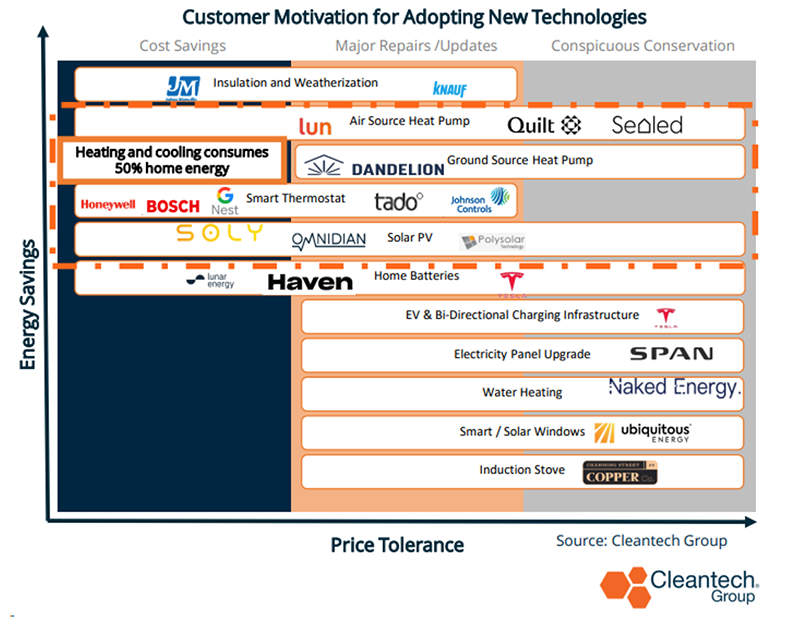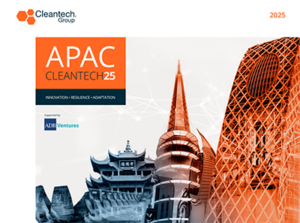Pathways Towards Decarbonizing Homes: Gaining Traction with Customers and Reducing Customer Acquisition Costs
The residential sector accounts 30% of global natural gas consumption (IEA) and 27% of global electricity consumption (IEA). With these staggering numbers, tackling home decarbonization and accelerating the rate of electrification are crucial to meet net-zero goals.
Residential homes have a variety of pathways to decarbonize including improving energy efficiency, managing energy loads, and electrifying systems to reduce costs. Upgrades can include installing home solar, batteries, heat pumps, improving insulation, and leveraging smart thermostats and electrical panels. Low carbon technologies are often at a premium to incumbent solutions, while cumbersome regulation and lack of awareness also stifles progress.
However, unlike decarbonizing heavy industry where the actions of a few key corporate players can have an outsized impact, widely decarbonizing homes will require the buy-in from millions of homeowners across the globe who must be incentivized to adopt new technologies to reduce their overall carbon emissions, natural gas consumption, and electricity use.
What Motivates Customers to Adopt New Technologies?
Three main motivating factors can be used to define customer groups:
- The first group can include those looking to primarily reduce costs and save money on energy bills
- The second group can focus on those upgrading and retrofitting their homes, who can take on costly builds and implement new technologies during that process
- A third group targets conscious consumers specifically looking to decarbonize homes who have extra cash in hand to pay for premium products
Companies that are gaining traction the fastest with customers and are rapidly expanding are those that can reduce energy costs for consumers while providing the lowest costs to install and implement.
Key actions like insulating homes, installing heat pumps, integrating smart thermostats, and adding solar PV can all provide tangible energy savings. Given over 50% of home energy is used for heating and cooling, low carbon alternatives to air conditioners and gas heating like heat pumps can create meaningful impacts if installed widely. However, there have been challenges to scale.

Decarbonized Home Innovation
Heat pump installations can be costly, some companies are going through manufacturing and supply chain challenges, and there are geographic restrictions with ground source heat pumps which require drilling. But one of the ways heat pumps can scale more readily now is because sales processes are becoming more efficient as a result of digital tools used in the process. Software that creates digital maps of specific regions and potential install locations can reduce manual labor, optimize sales processes, and reduce customer acquisition costs.
Other technologies that are also developing cheaper and easier to install products include smart panel developer Span, smart thermostat manufacturer tado, home battery developer Sunamp, and many others.
Companies are looking to reduce costs and gain customers in several ways. Some companies, like tado, are choosing to enter homes with a cheaper product like a smart thermostat which can retail between $200-$400 and can reduce energy bills on average by up to 22%. This has allowed tado to rapidly expand in European markets and gain a widespread and satisfied customers base.
Other companies like Enpal, 1Komma5, Lunar Energyand Swell Energy are providing a wide range of services (e.g., smart energy management, solar install, home batteries, etc.) and can support homes integrated into virtual power plant networks to recoup energy costs. By having this one-stop-shop, like business models, soft costs for prospecting, quoting, and installing can be optimized across devices and services to pass on lower costs to the customer.
Regulatory Effects
Federal and regional policies across the globe have also been accelerating the adoption of new technologies in homes. The U.S. IRA has provided substantial tax breaks for devices like heat pumps and have even allocated funding for smart panel retrofits supporting companies like Span, who would normally target more conscious consumers, attract a wider customer base.
Additionally, policies in regions of the world like Norway and Sweden have made it so that heat pumps are widely the more cost-effective option. When gas is extremely expensive, heavily taxed, and there is a ban on fossil fuel boilers, these regulations accelerate the adoption of heat pumps.
Looking ahead, key elections across a variety of countries may further advance or challenge existing legislation on certain rebates and tax credits. Additionally, as companies target customer bases outside of those with disposable income and more towards those that can recoup immediate cost savings, we’ll see a wider uptick in low carbon solutions entering more homes. While there may be many players in the market, there is still room for new entrants providing high quality products and services. Especially in sectors like smart panels and water heating, there is still quite a bit of room for new players and further cost reduction.



